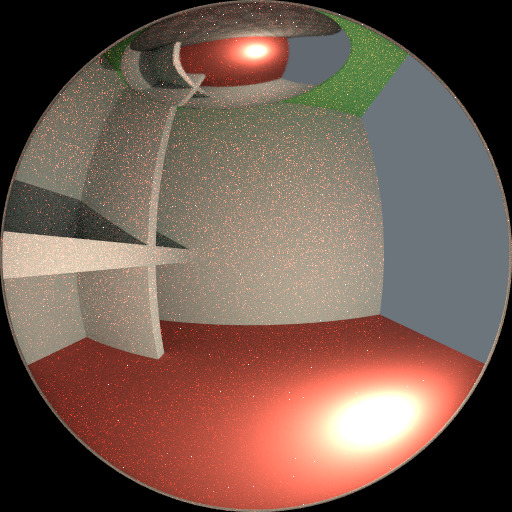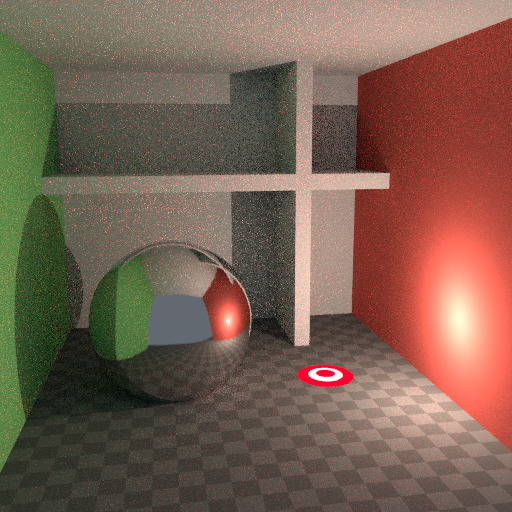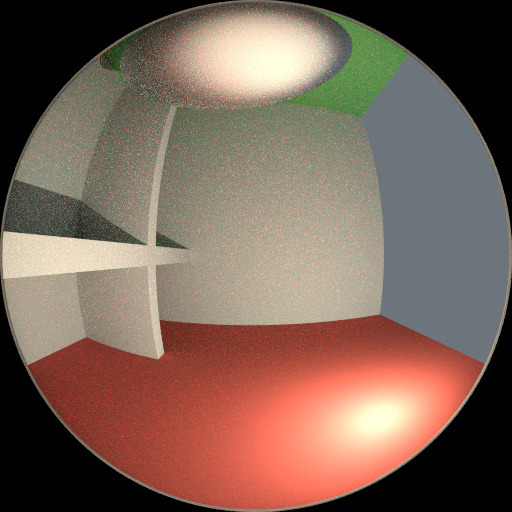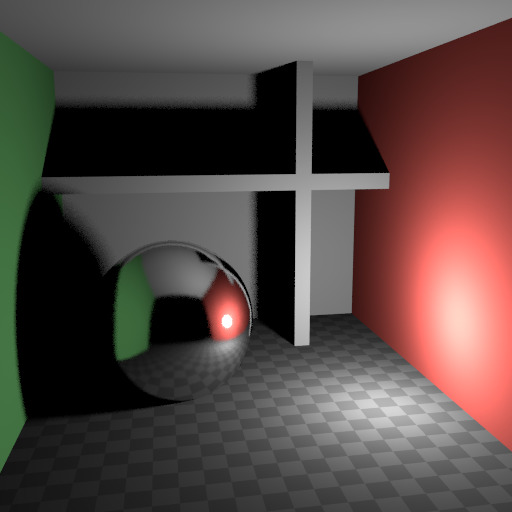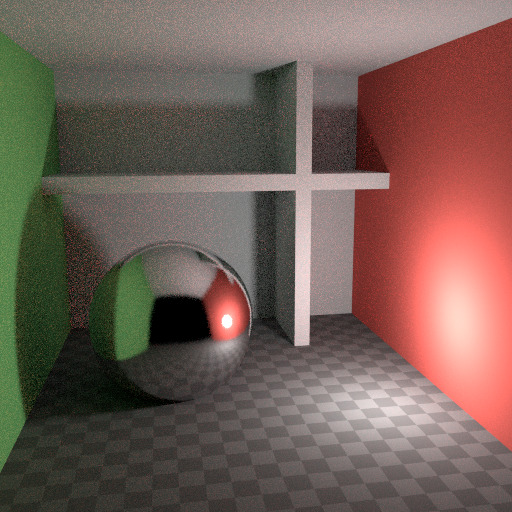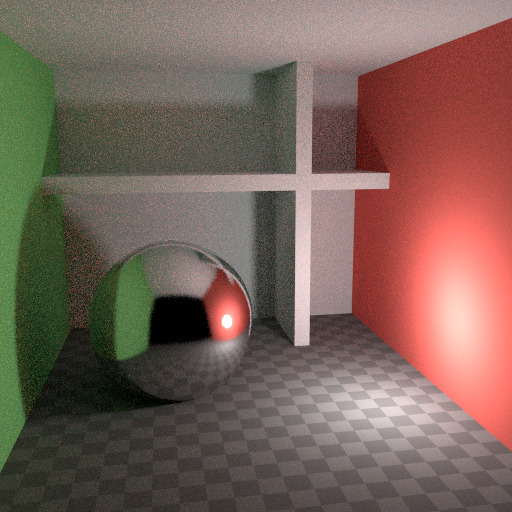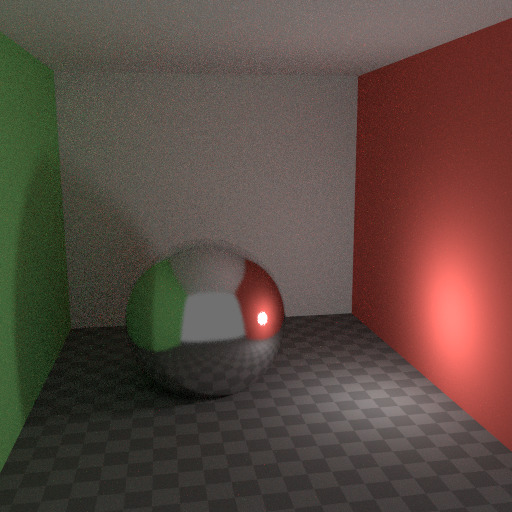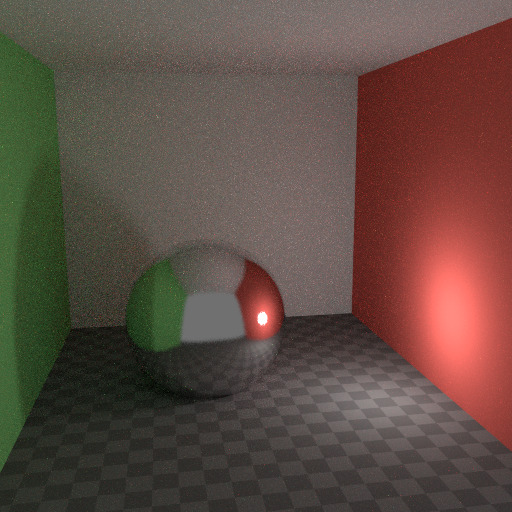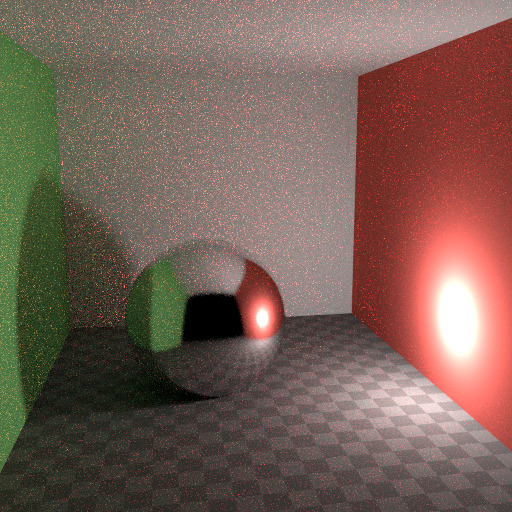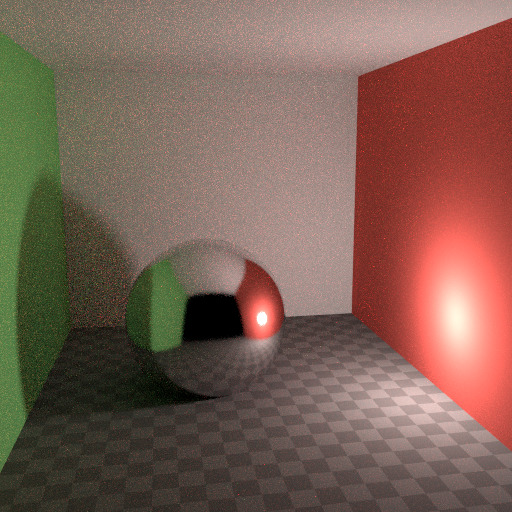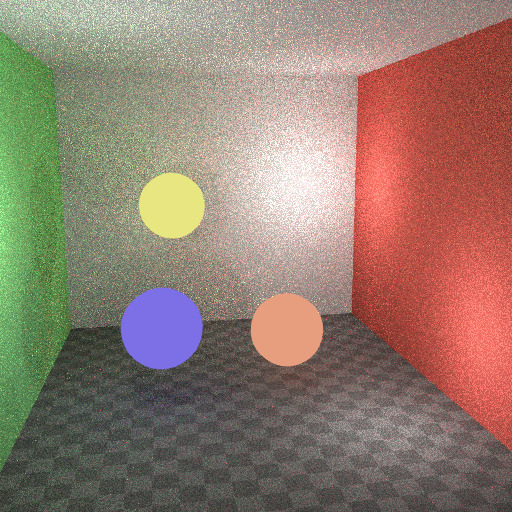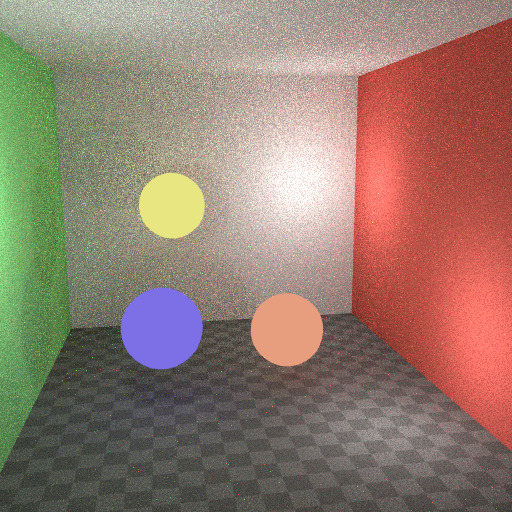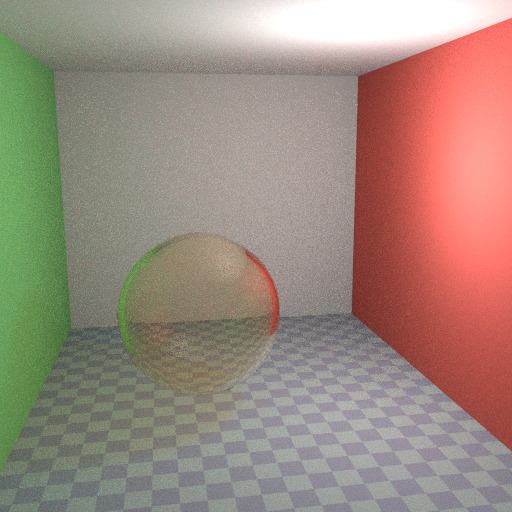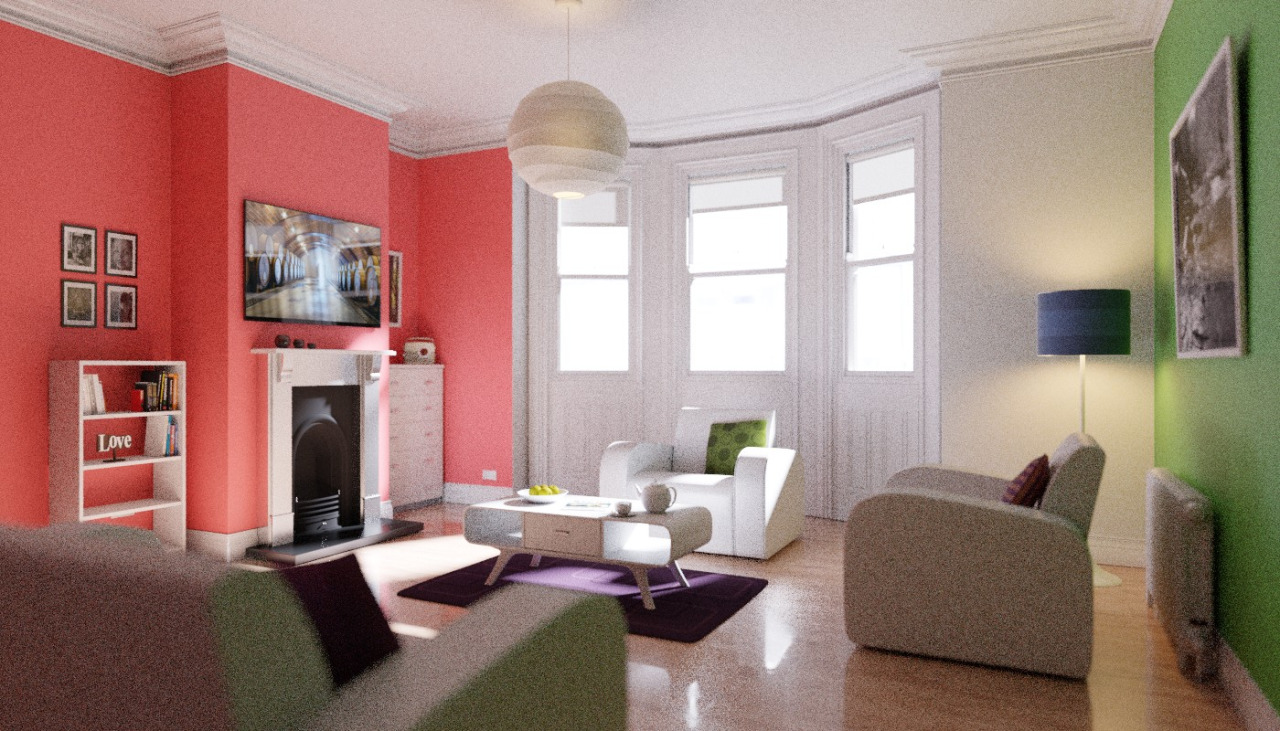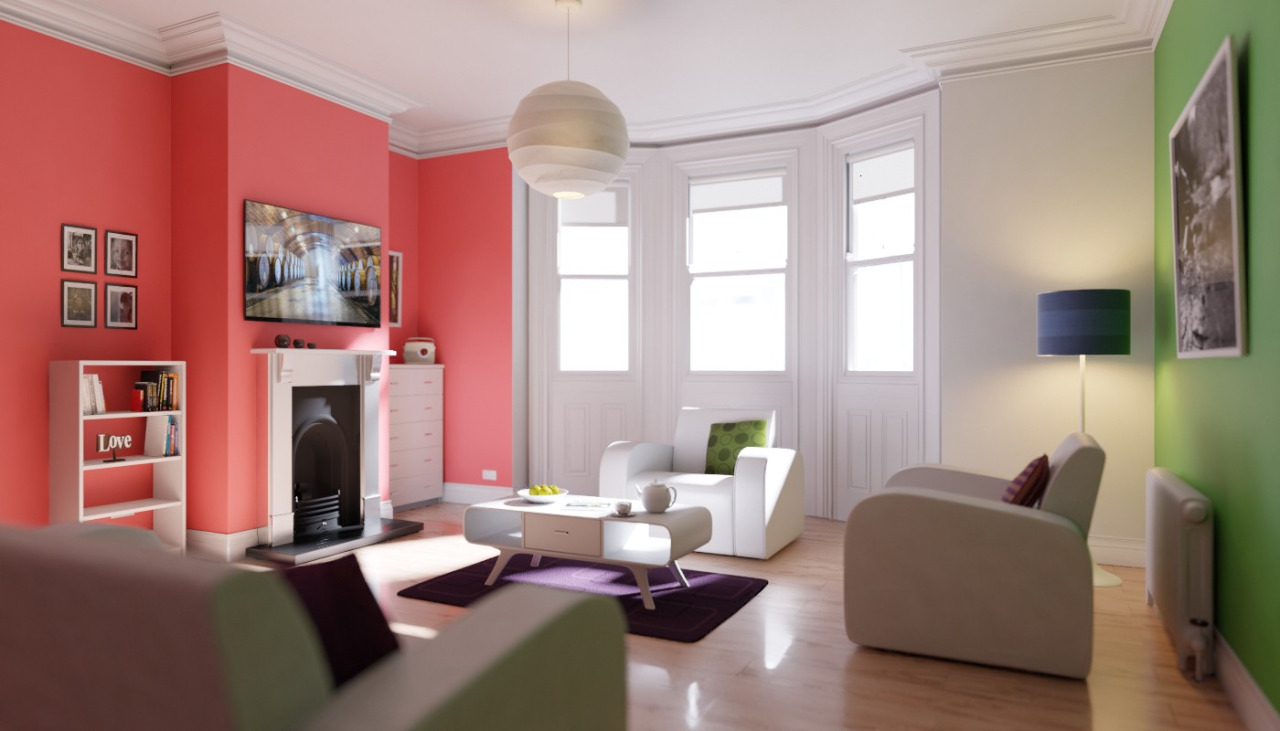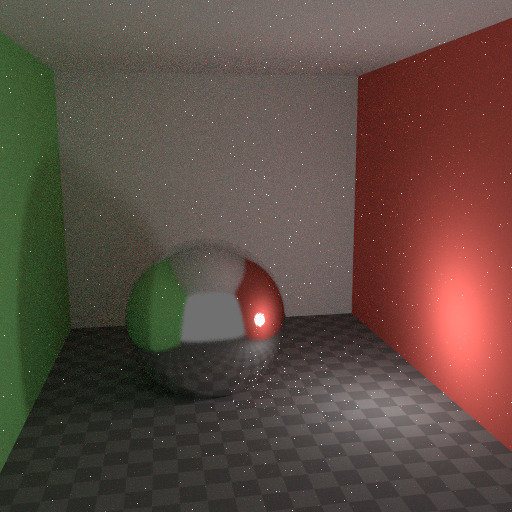Reducción de ruido¶
When performing a final render, it is important to reduce noise as much as possible. Here we will discuss a number of tricks that, while breaking the laws of physics, are particularly important when rendering animations within a reasonable time. Click to enlarge the example images to see the noise differences well.
Trazado de trayectorias¶
Cycles uses path tracing with next event estimation, which is not good at rendering all types of light effects, like caustics, but has the advantage of being able to render more detailed and larger scenes compared to some other rendering algorithms. This is because we do not need to store, for example, a photon map in memory, and because we can keep rays relatively coherent to use an on-demand image cache, compared to e.g. bidirectional path tracing.
We do the inverse of what reality does, tracing light rays from the camera into the scene and onto lights, rather than from the light sources into the scene and then into the camera. This has the advantage that we do not waste light rays that will not end up in the camera, but also means that it is difficult to find some light paths that may contribute a lot. Light rays will be sent either according to the surface BSDF, or in the direction of known light sources.
Ver también
For more details, see the Light Paths and Sampling documentation.
El origen del ruido¶
To understand where noise can come from, take for example the scene below. When we trace a light ray into the location marked by the white circle on a red dot, the second image below gives an impression of what the diffuse shader «sees».
To find the light that is reflected from this surface, we need to find the average color from all these pixels. Note the glossy highlight on the sphere, and the bright spot the light casts on the nearby wall. These hot-spots are much brighter than other parts of the image and will contribute significantly to the lighting of this pixel.
The light is a known light source, so its location is already known, but the glossy highlight(s) that it causes are a different matter. The best we can do with path tracing is to distribute light rays randomly over the hemisphere, hoping to find all the important bright spots. If for some pixels we miss some bright spot, but we do find it for another, that results in noise. The more samples we take, the higher the probability that we cover all the important sources of light.
With some tricks we can reduce this noise. If we blur the bright spots, they become bigger and less intense, making them easier to find and less noisy. This will not give the same exact result, but often it’s close enough when viewed through a diffuse or soft glossy reflection. Below is an example of using Glossy Filter and Light Falloff.
Rebotes¶
In reality light will bounce a huge number of times due to the speed of light being very high. In practice more bounces will introduce more noise, and it might be good to use something like the Limited Global Illumination preset in the Light Paths Section that uses fewer bounces for different shader types. Diffuse surfaces typically can get away with fewer bounces, while glossy surfaces need a few more, and transmission shaders such as glass usually need the most.
Also important is to use shader colors that do not have components of value 1.0 or values near that; try to keep the maximum value to 0.8 or less and make your lights brighter. In reality, surfaces are rarely perfectly reflecting all light, but there are of course exceptions; usually glass will let most light through, which is why we need more bounces there. High values for the color components tend to introduce noise because light intensity then does not decrease much as it bounces off each surface.
Cáusticas y filtrado de reflejos¶
Caustics are a well-known source of noise, causing Fireflies. They happen because the renderer has difficulty finding specular highlights viewed through a soft glossy or diffuse reflection. There is a No Caustics option to disable glossy behind a diffuse reflection entirely. Many renderers will typically disable caustics by default.
However, using No Caustics will result in missing light, and it still does not cover the case where a sharp glossy reflection is viewed through a soft glossy reflection. There is a Filter Glossy option to reduce the noise from such cases at the cost of accuracy. This will blur the sharp glossy reflection to make it easier to find, by increasing the shader Roughness.
The above images show default settings, no caustics, and filter glossy set to 1.0.
Decaimiento de las luces¶
In reality light in a vacuum will always fall off at a rate of 1/(distance^2). However, as distance goes to zero, this value goes to infinity and we can get very bright spots in the image. These are mostly a problem for indirect lighting, where the probability of hitting such a small but extremely bright spot is low and so happens only rarely. This is a typical recipe for Fireflies.
To reduce this problem, the Light Falloff node has a Smooth factor, that can be used to reduce the maximum intensity a light can contribute to nearby surfaces. The images above show default falloff and smooth value 1.0.
Muestreo de importancia múltiple¶
Materials with emission shaders can be configured to use Multiple Importance Sampling (Opciones de material). This means that they will get rays sent directly towards them, rather than ending up there based on rays randomly bouncing around. For very bright mesh light sources, this can reduce noise significantly. However, when the emission is not particularly bright, this will take samples away from other brighter light sources for which it is important to find them this way.
The optimal setting here is difficult to guess; it may be a matter of trial and error, but often it is clear that a somewhat glowing object may be only contributing light locally, while a mesh light used as a light would need this option enabled. Here is an example where the emissive spheres contribute little to the lighting, and the image renders with slightly less noise by disabling Multiple Importance on them.
The world background also has a Multiple Importance (Opciones) option. This is mostly useful for environment maps that have small bright spots in them, rather than being smooth. This option will then, in a preprocess, determine the bright spots, and send light rays directly towards them. Again, enabling this option may take samples away from more important light sources if it is not needed.
Vidrio y sombras transparentes¶
Cuando las cáusticas se encuentren deshabilitadas, las sombras de los vidrios podrían aparecer demasiado oscuras y el filtro de difuminado podría hacer que queden demasiado suaves. Será posible configurar un sombreador de vidrio que utilice un BSDF Vidrio al ser visto de forma «directa» y un BSDF Transparente al ser visto de forma «indirecta». El BSDF Transparente será usado para que las sombras transparentes encuentren fuentes de luz a través de las superficies y también produzcan sombras coloreadas de manera apropiada (aunque sin cáusticas). El nodo Trayectoria de rayo será usado para determinar cuándo usar cada uno de los sombreadores.
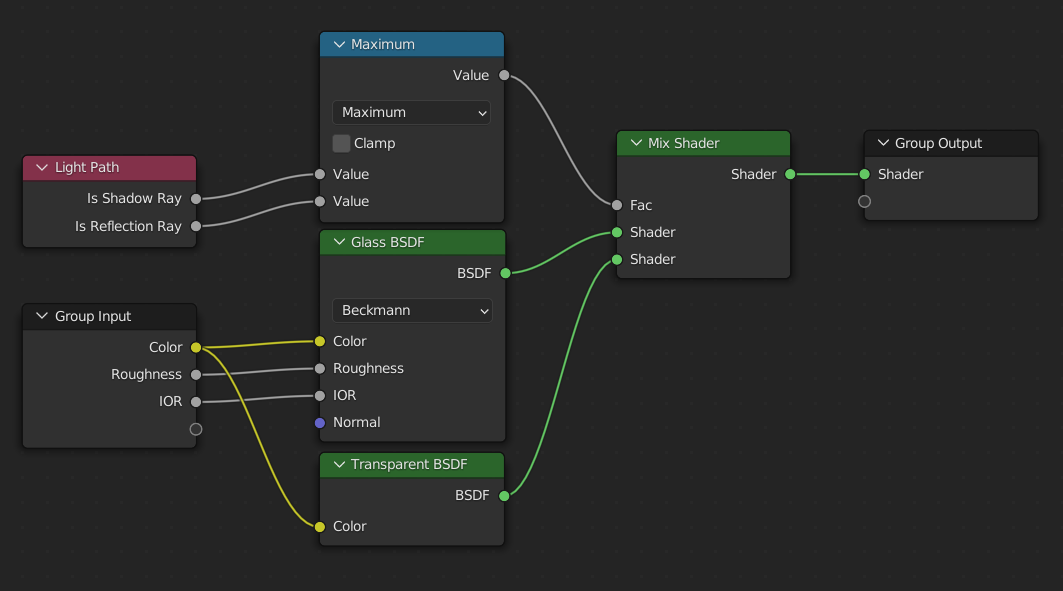
Sombreador de vidrio optimizado.¶
Arriba se puede apreciar la configuración de nodos usada para lograr el truco con la transparencia del vidrio. Abajo: del lado izquierdo la imagen procesada tiene sombras oscuras debido a las cáusticas faltantes, del lado derecho se muestra la imagen procesada usando el mencionado truco.
Portales de luz¶
Al procesar escenas de interiores diurnas, en donde la mayor parte de la luz proviene desde el exterior, a través de ventanas o puertas, resulta difícil para el integrador encontrar el camino hacia estos lugares. Para aliviar este problema, será posible usar Portales de luz, modificando su forma para que se ajusten a las aberturas por donde debe entrar la luz.

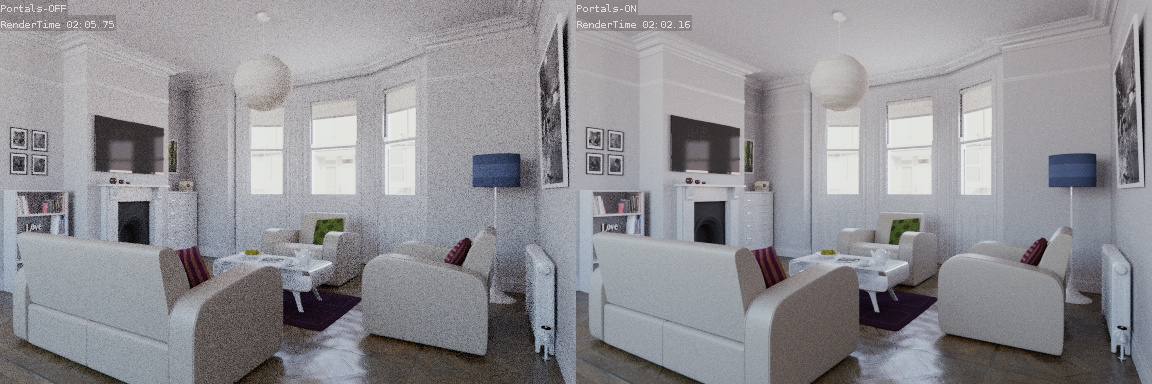
Reducción de ruido¶
Aún con todas las opciones descriptas arriba, siempre terminará existiendo algún grado de ruido en el procesamiento, sin importar la cantidad de muestras usadas. Para corregir esto existe una técnica de pos procesamiento que permite reducir el ruido de la imagen final. Para usar este método, habilitar la Reducción de ruido en la pestaña Procesamiento de las Propiedades.
Below is an example render by The Pixelary.
Atenuación de luciérnagas¶
Idealmente con todos estos trucos previos, las Luciérnagas deberían haber sido eliminadas, pero es posible que aún aparezca alguna. Para esos casos, será posible limitar la intensidad que cualquier muestra individual de rayo de luz sea capaz de contribuir al color final de un píxel a un valor máximo, mediante las opciones de Limitación del panel Trayectoria de rayos.
En caso de que este límite fuera establecido a un valor demasiado bajo, esto podrá causar la ausencia de destellos naturales en la imagen, que pueden ser necesarios para lograr efectos de cámara como resplandores o halos. Para encontrar un punto medio apropiado para este dilema, suele ser útil limitar únicamente los rebotes de la iluminación indirecta, dejando intactos los destellos visibles directamente a la cámara.

